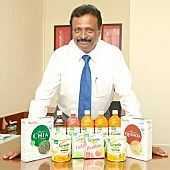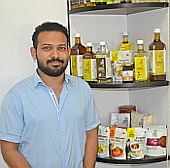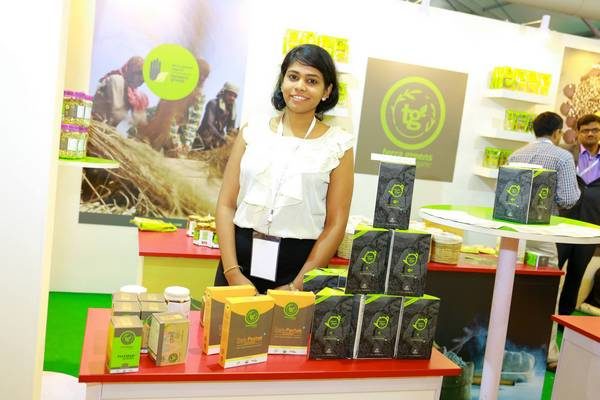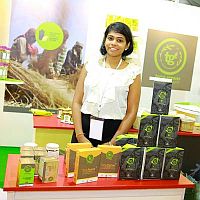By Rutaksha Rawat (with inputs from Ken Research, TechSci Research & APEDA)
Filliped by economic rise, diverse agro climate, renewed govt succour, improved production standards, as well as, a growing retail consumerbase with tremendous latent growth, the Indian Organic Food Market offers promise to all stakeholders—domestic and international
The Indian Organic Food Market remains an export led one and will continue to grow, with players increasing their range of export offerings and aligning themselves more staunchly with world standards. However, new favourable developments in the domestic market also indicate the Indian Organic Food Industry is at the threshold of high retail revenue and consequently, robust business to business sales. “There’s a rising consciousness amongst Indian consumers to eat healthy. An increasing number of consumers are enquiring about the ingredients used in food products and are asking searching questions. Consequently, the industry is aligning its business strategies to respond to this new emerging consumer buying behaviour by increasing product ranges offered. The B2B segment is also increasingly looking for organic ingredients. Therefore, the overall market is growing at a healthy pace,” says R Durairaj, founder and CEO, Mother India Farms (MIF), Bengaluru, one of India’s largest exporters of organic juices, purees and individual quick freezing (IQF) products. MIF is also the producer of the Organa brand of certified organic juices in the domestic market.
“The domestic market for organic foods in the country stands approximately at Rs 300 to 400 crore (approx USD45 to 60 mn), whereas exports stand at Rs 2,500 crore (approx USD401 mn). Both are growing at the rate of around 30% year-on-year,” says Surya Shastry, director, Phalada Agro Research Foundations Pvt Ltd, Bengaluru, a prominent exporter of spices, herbs, coconut and coffee to more than 20 countries in the world, as well as, producer of the Pure & Sure retail brand of organic foods.
In the current scenario, says Ken Research (global industry research firm), promising opportunities for organic food producers lie in the regional markets, given India’s vast populace of 1.2 bn people, of which 250 mn make up the middle class. According to its report, India Organic Food and Beverages Market Outlook to 2019, with more consumers shifting to organic foods and beverages, the domestic market exhibited a CAGR of 33% from FY’2010 to FY’2014. “The colossal consumer base in the country represents a huge domestic market, reason why even large MNCs like Amazon and Walmart have entered the Indian market,” says Shrikant Sharma, CEO, Sanjeevani Organics, Dehradun, an emerging leader in B2B, retail and export of organic foods.
Domestic growth, say industry experts, emerges from various factors—broadly including—increased disposable income, higher awareness of organic foods, greater availability; and increased costs of conventional mainstream food items, leading organic products to be perceived as more affordable to consumers. “Consumers are not only becoming more aware of the benefits of organic foods, but also they are slowly beginning to trust brands due to continued exposure and growing awareness,” says N Balasubramanian, CEO, Sresta Natural Bioproducts Pvt Ltd, Hyderabad.
The forecasts, too, seem promising. According to global market research firm, TechSci Research’s report, India Organic Food Market Forecast & Opportunities 2019, the Indian Organic Food market is poised to grow at a CAGR of 24.49% during 2015 to19.
Industry insiders concede to the forecasts of market research agencies, estimating the total turnover of the market in 2015-16 to cross a billion USD. “Current Indian sales figures represent less than 1% of the global organic F&B market, indicating vast potential. The industry has the potential to grow by 100 to 150% per year,” says Mukesh Gupta, executive director, Morarka Organic Foods Ltd, Jaipur.
Government focus on organic production of individual states has further helped harness a regional organic revolution across states such as Kerala, Sikkim, Uttarakhand, Himachal Pradesh. “At present, in Kerala, an absolute organic revolution is taking place. Today, the state is taking care of 70% of its organic vegetables demand itself compared to 20% just a few years ago. This is one of the main reasons why BIOFACH INDIA together with INDIA ORGANIC fits in well with Kochi,” says Sonia Prashar, managing director, NürnbergMesse India Pvt Ltd, the Indian representative of the NürnbergMesse Group, Germany. BIOFACH INDIA, the only trade fair for the Indian organic industry is being hosted in November 2015 in Kochi, Kerala in its seventh edition.
In 2012, India’s organic food export value was approximately USD374 mn, which is further expected to grow in the forecast period (2015-19; Tech Sci Research). “In view of the growing demand in the organic global market of USD72 bn, there is great potential for export of organic products from India. The advantage India has is on account of its varied agro climatic conditions and traditional organic resources, due to which we can produce and supply varieties of products though the year. Non commercialisation of edible (genetically modified organism) GMO crops in India has given further importance to our country as a supplier of organic products,” says Dr PVSM Gouri, advisor, Organic Products, Agricultural and Processed Food Products Export Development Authority (APEDA).
Furthermore, the organic nutmeg, coconut milk and oil from India have become coveted in the world market, where they command premium prices. “We have American buyers willing to procure organic nutmeg, organic coconut milk and oil. They fetch 20-30% more price in the export market,” says Manoj Menon, executive director, International Competence Centre for Organic Agriculture (ICCOA).
Moreover, Indian exporters, to feed the demand for global products, have begun domestic production of internationally coveted crops. “We have started quinoa production last year and received encouraging results. Therefore, we will continue growing the grain crop for both the domestic and export markets,” says Yogesh Joshi, director, Rapid Organic Pvt Ltd, Rajasthan, a B2B provider and exporter of organic seed spices to USA, Canada and Japan, as well as, producer of the Mahiya brand of multigrain breakfast cereal in the domestic market.
The organic farming market, too, is growing steadily. According to BIOFACH INDIA, it is growing at 40% annually and is poised to touch Rs 5,000 crore (approx USD755 mn) in the next three years. “Events such as ours make farmers aware of the benefits of organic farming and organisations such as ICCOA organise direct programmes, which include a complete cycle from registering the farm for conversion to getting it certified in three years,” says Prashar.
Trends & Developments
Despite the spurt in domestic growth, however, it is really the entire organic food sector as a whole that has picked up pace—domestic, export, retail and e commerce—with all stakeholders recording growth and new players jumping in the fray frequently. Thus, the market now comprises a vibrant melange of producers, exporters, local traders, retailers, e-tailers and rural and urban farmers.
While specialty organic shops and gourmet stores have, for some time, catered to the nascent organic foods segment, a distributional spread towards mainstream outlets is occurring in metropolitan cities, with almost all supermarkets and modern trade stores displaying organic products on their shelves.
While certification is mandatory for exports, some products for domestic consumption remain uncertified, as their producers are either marginal farmers, small co-operatives or tradefair companies. These do fairly well in regional markets. “It is a farmer and civil society led initiative to operate such markets. However, such initiatives are limited in resources and receive little or no support from the government. Hence, this is a low scale operation,” says Ashish Gupta, VP, International Federation of Organic Agriculture Movements – Asia (IFOAM-Asia); managing committee member of the Organic Farming Association of India (OFAI) and founder, Jaivik Haat, a retail e-store selling organic products of small scale farmers.
In the domestic market, organic processed foods are the highest selling products, primarily including snacks, baked foods, dry fruits, pickles and ready-to-eat foods (TechSci Research). The demand for these products is growing due to the high inclination among consumers towards ready-to-eat foods, as well as, the need to replace regular potato crisps and deep friend Indian packet snacks with easy-to-eat packaged snacks that are healthy and organic.
Also in demand are fresh organic fruits and vegetables, and farm fresh meats. “Many of our regular customers are those who want only organic fruits and vegetables. There is also a demand for farm fresh meats,” says Ayesha Grewal, founder, The Altitude Store, the capital’s most popular organic-only retail shop.
Superfoods is another food segment that has witnessed a surge in demand due to heavy positive media coverage on their health benefits. “Even those that don’t want to buy organic staples consider it a must to buy superfoods, as they perceive them as medicinal and disease thwarting. Our top selling products are sunflower, pumpkin, chia, and flax seeds,” says Nisheet Agarwal, partner, Rainbow Organics, Kolkata, the city’s largest and perhaps only organic specialty store.
There is also a growing demand in urban cities for handcrafted artisanal foods such as cheeses, jams and sauces, etc, and a host of small scale and mom-and-pop players are catering these to consumers through retail stores, Farmers’ Markets and even through Organic Buyers’ groups on Facebook. Many of these products have Food Safety and Standards Authority of India (FSSAI) labels but several are purchased “on trust”, with customers establishing trust via detailed enquiries or personal visits to the sellers’ farms.
Artisanal products, although small scale, hold appeal for buyers, as they view them as more pure and fresh, being handmade and most likely emanating from a home kitchen environment. Therefore, while staples like pulses, spices, flours and rice are preferred from larger companies, for certain processed foods, consumers like to turn to small scale artisanal operations. Retail outlets such as The Altitude Store stand out as having vast ranges of handcrafted offerings. In addition to mass produced staples, Altitude offers artisanal cheeses, preserves, sausages, and charcuterie products, which have endeared the store to a sizeable consumerbase of expat and national patrons.
Women and children drive buying decisions in India, as Indian women are mostly in charge of the kitchen and decide on pantry purchases. Children, too, are responsible for sales, as parents in India make their children’s nutritional needs top priority. “As per a Boston Consulting Group research, Indian women make the final decision in 8 out of 10 cases related to foods and groceries. Typically, they look for fruits and vegetables as an entry point into organics and gradually start buying other products also,” says Durairaj.
Major consumption of organic foods and beverages in the country is taking place in metropolitan cities, with awareness and demand slowly growing in tier 1 and tier 2 cities as well. The sale of organic food products is the highest in Mumbai, followed by Delhi NCR, Bengaluru, Ahmedabad, Hyderabad, Chandigarh, and Indore (Ken Research). However, as smaller cities afford home owners more space to cultivate small batches of produce of their own, small city and town dwellers tend to grow their own organic foods, with some making their own processed foods like jam, pickles, etc. “We eat all our vegetables and fruits off our organic kitchen garden and bottle pickles before vegetables go out of season,” says Kiran Mamgain, a native of Dehradun, Uttarakhand.
Despite organic foods being priced 20 to 30% higher than conventionally grown foods and beverages (Ken Research), consumers armed with better resources and knowledge of the benefits of organic products do not seem to mind paying extra. “Approximately 30% of organic food consumers are willing to pay 10 to 20% extra for organic foods,” says Karan Chechi, research director, TechSci Research. Furthermore, increased prices of mainstream foods have also helped tip consumers over. “With the prices of conventional food products increasing, organic food is being perceived as less expensive than it was earlier,” says Balasubramanian.
In terms of production, the state of Madhya Pradesh is the leader, with 83,404 tonne of organic food and beverages produced in FY’2012, as per Ken Research. The state is best suited for growing crops such as minor millets, organic soybean, and spices such as chilly, garlic and coriander. Madhya Pradesh is followed by Himachal Pradesh and Rajasthan in production volumes.
The stress within the industry is on farmer welfare and benefit. “To us, the farmer is a stakeholder, not a means to acquiring produce. Besides paying premium prices, we also provide education for their children, give veterinary aid for their animals and take them on international farming tours as part of our Knowledge Exchange Initiative,” says Sharma.
Rapid Organics, whose motto is, ‘Business with Farmers’ Happiness’, plans to go fairtrade for the benefit of its 5,000-strong network of farmers. “We pay our farmers additional premium and offer as much support as possible in terms of medical camps, tech and agri support, education for their children, training, etc, in order to diminish their expenses,” says Joshi, an erstwhile farmer himself, whose company, Rapid, is reputed amongst farmers for its fair payment practices. With a network of 20 national offices, 100 concurrent organic agriculture projects, and a large group of farmers encompassing 4,000 acres of certified organic land, Rapid offers 65 products—chiefly cumin, fennel, psyllium, coriander, fenugreek, carom, sesame, groundnut, mustard, and castor, amongst others.
Additionally, industry members are now more adherent than ever before to prescribed quality standards and practices. APEDA’s National Programme for Organic Production (NPOP) certification and TraceNet tracking software have ensured world class standards and forced businesses without formal approvals to either fold or adopt the proper channel of norms. This has helped the export business gain the confidence of clients in the global marketplace. “Thanks to TraceNet, Indian exports have been able to reach high standards in the world. The tracking site makes exporters’ credibility evident to buyers. This has helped in procuring business for us from the global market,” says Sharma.
Growth Drivers
In the present scenario, notable growth drivers for the Indian Organic Food market include: increased disposable income, increased awareness of organic foods, improving export standards, widening product categories across all formats, prolific coverage of food adulteration and toxicity; diverse agri climate, vast consumerbase, renewed government focus on the organic sector, positive international media coverage of organics, greater availability of organic foods in the market across varieties of product ranges; and increasing costs of conventional food items, leading organic products to be perceived as more affordable by consumers.
Furthermore, India’s increased GDP has given consumers the confidence to spend. With a GDP growth of 7%, India topped the Global Consumer Confidence Index on The Nielsen Global Survey (by global market research agency, Nielsen) in 2014.
Increasing affliction with lifestyle diseases, rampant food adulteration and instances of toxins being discovered in edibles, also contribute to escalated sales and mindset changes. “I have converted to organic foods due to frequent media coverage of toxin residues being discovered in tea, milk, and even Maggi,” says Parul Bhatnagar, a home maker from Delhi NCR.
Word of mouth too, has been instrumental in forming positive opinions amongst people and shaping future consumers. In most cases, relatives, friends and colleagues will start purchasing organic products after observing peers doing so first, or learning about organic foods during social interactions. Print media articles and social networks have also contributed to spawning awareness.
Flourishing B2B
The growing demand in retail has given rise to a robust B2B industry, as players buy from others to supplement their product ranges. Due to India’s varying agro climatic conditions across states, most companies are unable to harvest all crop varieties in their native states and therefore, reach out to B2B players to make up for missing products in their own ranges. B2B buyers purchase stock for both domestic trading and exports, depending on their business model.
Due to the high volumes involved, the B2B sector is a strong one and is expected to grow till retail exhibits demand. “B2B is definitely flourishing in the industry. As the number of retail brands increase, so will the scope of the B2B segment,” says Likitha Bhanu, executive director and general manager, Terra Greens Organic, Hyderabad, a 3,000-farmer strong player involved in retail, export and B2B, with almost 100 products and a brand new range of organic ready-to-cook upma* and khichidi * mixes launched recently in the retail market.
With an increment in organic food consumption in the home, consumers will also expect the same when they visit hotels, eateries, conferences or host weddings, leading to increased B2B sales. “There’s an emerging potential in corporate, hospitality and catering sectors that’s beginning to unfold,” says Durairaj.
Most industry members believe B2B and retail are complimentary and one cannot thrive without the other (especially B2B, without retail). However,
Rapid Organic, which has established itself as a largely B2B player, begs to differ. Although Rapid does have an export portfolio as well, it has till now refrained from entering retail. “We have thrived without retail. A customer may stop purchasing a particular product from the retail shop, but B2B businesses will constantly develop new products to suit changed consumer behaviours—with the same raw ingredients. In that regard, I think, B2B is not reliant on B2C and not entirely at the mercy of end consumers,” says Joshi. Rapid, is, however, on the brink of unveiling its first retail brand, Mahiya, which will introduce a multigrain organic breakfast meal in the market. For Joshi, this is a natural progression of expansion and not necessarily a step towards filling a market void.
Retail & E-tail Scenario
According to a Research Report released by Google, the Indian e-tail market is set to touch USD15 bn by 2016. Therefore, both e-tail and organic food industry forecasts indicate success for e-tailers in the organic industry.
As retail demand picks up, more retail stores are setting up shop to exploit the growing organic foods market. But as bricks and mortar outlets entail higher expenditure, most players prefer to enter the market with e-commerce stores (with some like naturallyyours.in, which started out as a retail outlet but turned completely online to maximise profits). Therefore, the ratio of organic retail outlets is highly skewed in favour of online stores.
However, retail stores that set up shop and sustained themselves over years have built a more loyal clientbase that grows further through word of mouth and reference. In a bid to retain online consumers, these stores have quickly expanded their presence in the online domain as well, with most retailers reporting equal footfalls in both the physical and online formats. “We receive approximately 2,400 buying customers in each format per month,” says Grewal, whose store, The Altitude Store, is growing well over 30% annually across both formats.
It’s not only retailers that have entered the online space. Manufacturers such as Sanjeevani Organics, whose products are already available in the market through networks of distributors and retailers have also set up their own e-stores to compensate for the lack of exclusive retail outlets.
The physical retail store serves as a sensory interface to attract consumers and let them see, smell and even taste firsthand, the products that are available. E stores, on the other hand, are convenient buying options for repeat sales of products that are already familiar to shoppers. Therefore, both hold significance.
E commerce is not localised and orders span India-wide, notwithstanding the geographical location of the online seller. “Had online sales been localised, it would have been bad for us as almost 50% of our sales originate from South India. Being able to harvest pan India sales has helped us grow 30% month-over-month, and we are now geared to roll out industry related events and services under the banner of Eco Tokri Labs,” says Karnesh Mahendru, co founder, Eco Tokri, one of India’s largest online sellers in the organic domain.
With new online players setting up shop every day, there is room for all, as the online retail industry for organic foods is experiencing a boost of 20 to 30% growth according to Vinod Chendhil, founder, naturallyyours.in, which has built a massive pan India consumerbase over the years. “With the industry on a growth path, I think there will be scope for everyone to grow. First movers and heavily funded organisations have an edge over the others. But new e-tailers can do well if they carve out their own niche proposition and don’t just copy paste from other portals,” says Chendhil, whose business has witnessed an annual rise of 50% since inception in 2010.
Export
India is a rich resource for organic products for global buyers, producing approximately 1.24 mn MT of certified organic products per year. It is estimated that 65% of the country’s cropped area is organic by default, as small farmers had no choice but to farm without chemical fertilisers and pesticides which they could ill afford.
Currently, the country ranks 10th in the world, in terms of cultivable land under organic certification, with the total area under organic certification being estimated at 4.72 mn ha (2013-14). The export of Indian organic foods is expanding at a significant pace owing to increasing global demand for organics, diverse agri climatic conditions, significantly improved quality standards, non commercialisation of GMOs; and a growing demand for ethnic products abroad owing to the expanding South Asian community there. International trade in organic foods displayed an annual surge of 20 to 22% during FY’2009 to FY’2014, as per Ken Research.
| Year | Area
(Mn ha) including wild |
Production
(Mn MT) |
Export
(Quantity in MT) |
Export
(Value in crore Rs) |
Export
(Value in mn USD) |
| 2014-15 | 4.9 | 1.1 | 285663 | 2100.00 | 327 |
| 2013-14 | 4.72 | 1.24 | 177765 | 1328.61 | 220 |
| 2012-13 | 5.21 | 1.34 | 160276 | 1155.81 | 213 |
INDIAN ORGANIC EXPORT
(Source: Data provided by the accredited certification bodies under NPOP on TraceNet)
According to Gouri, there are currently only 608 exporter in India, and they exporting mainly commodities (96%) such as basmati rice, soya bean, sesame, dried fruits, pulses, spices, herbs, sugar and honey, as well as, primary processed products such as tea, coffee, mango puree, soya meal, and herbal oils. Furthermore, processed products account for only 4% of the total export market, mainly constituting chutneys, poppadom, soups, confectionary items and essential oils. Therefore, there is scope for more exporters to join the world market, as well as, for more products to be offered in the processed foods category.
The B2B segment in exports is an especially promising sector according industry insiders. “All our exports are done in bulk packaging (B2B) or in private label,” says Shastry, whose company, Phalada, exports to USA, Germany, UK, France and Switzerland. A prolific producer of organic spices, Phalada has been awarded the ‘Topmost Exporter of Organic Spices’ award by the Spices Board of India. Established in 1999 with export operations, in 2012, the company entered the retail market with its domestic retail brand, Pure & Sure, which enjoys pan India distribution.
Long time importers also expect international trade to escalate. “We have been buying organic raw materials from India for the last 14 years. As Pukka grows, India will become more important to us as a country for both sales and raw materials supply,” says Sebastian Pole, co founder, Pukka Herbs, UK, which imports over a hundred tonne of organic herbs and tea from India every year.
The Indian government has given impetus to exports by putting in place requirements that ensure 100% quality. It has incorporated the NPOP, an accreditation programme for certification bodies, standards for organic production, and promotion of organic farming. The NPOP accreditation has been recognised by the European Commission, Switzerland and USA as equivalent to their country standards.
Similarly, APEDA has put in place TraceNet, a sophisticated tracking software designed to monitor production and export activities. Any enterprise working through TraceNet has to mandatorily submit detailed crop related data online—such as yearly crop planning, crop details, quantum of certified land, and even GPS data of the land (to verify its existence). In short, everything related to the produce is painstakingly fed into TraceNet at every stage of production. Such checks and balances have left little scope for fraudulent production, and have inspired confidence in global buyers.
Seeking to leverage the increased global demand for organic foods, Indian players that are already involved in export seek to widen their international portfolios. “We already export to countries in the European Union and USA but are now looking to expand to other international markets very soon,” shares Bhanu.
Players like Sanjeevani Organics, which is catering for the international market through its export flagship, Sanjeevani Organics USA, want to expand by offering diverse products for both the B2C and B2B export industries. The company has recently commenced export of organic frozen vegetables, and intends to render B2B export offerings in the near future.
MIF, which exports IQF products such as mango and pineapple, chiefly to Europe, now also wants to enter other continental markets while simultaneously focusing on its domestic offering, Organa.
JVs & VCs
The success of the organic food and beverages segment has begun to attract private equity and venture capital. In recent time, 24 Mantra (Sresta Natural) has received USD15 mn from institutional investor Peepul Capital, along with funding from Ventureast, an Indian VC fund manager. The company has also entered into a JV with ethnic organic food company Fyve Elements (USA), which has been successful. “Our association with both Ventureast and Peepul Capital has been fruitful. They have supported our growth plans and have helped with strategic inputs as well,” says Balasubramanian.
Organicshop.in of Jaipur has also received its first round of seed funding from the Rajasthan Angel Investors Network (RAIN).
However, most industry members have reservations about funding, preferring to remain autonomous and grow organically for as long as possible. Still, many are open to the “right” partner, with some seriously considering joint venture initiatives to expand in particular markets.
Terra Greens, which has been self funded till now is considering investor proposals. “I think it is important to make sure the right kind of investors become a part of your organisation. We are looking at investment and have been approached by many funds. But we are very particular about not diluting the quality or the purity of the brand and we don’t want to be in any undue pressure to grow. We will only get someone on board, who shares the same ideas and principles,” shares Bhanu.
MIF, which deals in approximately 50 agricultural products, is geared to exploit the opportunities in global markets. “We are open to strategic partners to join us in our exciting growth story. After having launched India’s first certified organic fruit juices in 2012, we are pleased with the progress in our domestic business. We believe in expanding our products, simultaneously in both international and Indian markets,” says Durairaj.
Stumbling Blocks & Proposed Solutions
The Indian Organic industry continues to suffer some limitations—mainly—high costs, expensive certifications, high import taxes and a sluggish conversion rate to organic farming.
Farming challenges also need to be addressed to make progress at the grass roots level. “Several issues and challenges are yet to be surmounted in the organic sector— building capacities of farmers in organic farming systems and markets; the need for a strategic focus of policies for organic agriculture; the need for comprehensive research on farming systems and markets for organic produce; and production of more organic inputs,” says Prashar.
The higher price of organic foods continues to deter large numbers of consumers from converting to organic, although this gap is getting slimmer with conventional foods becoming costly. Organic foods cost more as their production is labour intensive and therefore, a higher premium (10-15%) is given to farmers in order to incentivise them (Ken Research). Furthermore, the processing cost for organic food is higher (12-13%), as no chemical fertilisers and pesticides are used in the production process. In India, cost incurred on training farmers accounts for 8 to10% of the cost of organic foods and beverages (Ken Research). Therefore, it is a challenge for organic food producers to lower costs for consumers while also striving to maintain quality.
“We, as producers, should decrease margins to see positive changes. It is true the retailer adds wide margins to products, rendering them expensive. But if the company decides to offer a quality product at affordable prices, the end consumer will repeatedly buy it and even demand for that particular brand. Therefore, our 100% concentration should be on acquiring consumers. The rest will fall into place” suggests Joshi.
Importers like Pukka find exorbitant import taxes to be a huge impediment to successful trade. “The Indian government imposes a 100% tax on the import of herbal teas. The organic regulators APEDA would do well to help minimise bureaucracy and increase the rigour of audits to maintain organic integrity and facilitate ease of business,” suggests Pole. “Investment in machinery and equipment for efficient processing and improved consistency in quality will be another key for success going forward,” he adds.
Exporters find that though global demand is high, production volumes at home are not at par with demand. “To fuel the growing demand in the B2B sector and the export market, production needs to increase. We are converting farmers but the rate of growth is not enough to supply to the growing demand for high quality organic produce,” says Bhanu.
Organic farming scientists opine the farmer is receiving an unfair deal in equation and is being expected to adhere to expensive standards that can only be afforded by large outfits. “Certification is a costly and cumbersome process and is not feasible for a majority of farmers, who are poor and unable to maintain records. An annual inspection/certification fee currently starts at Rs 5,000 to 5,00,000 (approx USD79 – 7,884) per year. A common farmer has no choice but to associate himself with big companies if he wants to export his product, as Participatory Guarantee Systems (PGS) is not so well accepted till now,” says Dr Arun K Sharma, senior scientist, organic farming, Central Arid Zone Research Institute, Jodhpur.
To make organic production more inclusive, the Indian government has introduced PGS, an alternative to third party certification, especially designed for local markets and short supply chains.“This is the first time the Ministry of Agriculture has floated a scheme called Paramparagat Krishi Vikas Yojana (PKVY) to push the idea of PGS as a viable means of certification through the National Mission on Sustainable Agriculture (NMSA). Produce sold under PKVY has grown over 200% year-on-year, which is a big achievement. Sufficient to show that it works on the ground and should be duplicated in a large way,” says A Gupta.
Govt Succour
The Centre and State governments are supporting the sector through various initiatives and schemes. The Indian government has adopted a proactive approach to increasing organic production and export and has bolstered the sector by allocating Rs 300 crore (approx USD45mn) to organic farming in 2015.
In 2014, Indian Prime Minister, Narendra Modi, was quoted as saying: “We see huge demand for organic products. People interested in holistic health are prepared to spend a lot of money on organic food, and the Indian government wants to be involved in satisfying this global demand.” In the Lok Sabha*, on another occasion during the same period, Modi stressed on transforming North East India into an ‘Organic State’ in order to cater for the global organic foods market. The Centre has allocated Rs 125 crore (approx USD19 mn) for the mission, spanning all North Eastern states, including Sikkim, which is on its way to becoming the first fully organic state in the country by the end of 2015.
In July 2015, the government also launched three agri portals to make the process of organic farming certification, fertiliser quality check and issuance of soil health cards, more transparent and accountable. These portals, launched in the English language, will be made available in regional languages for the convenience of farmers.
Several schemes to encourage organic food production have also been launched by the government, including the National Project on Organic Farming (NPOF); National Horticulture Mission (NHM); Horticulture Mission for North East and Himalayan States (HMNEH); Rashtriya Krishi Vikas Yojana (RKVY); and the Network Project on Organic Farming of Indian Council Agricultural Research (ICAR).
However, despite the allocation of funds and renewed emphasis on organic farming, the government needs to pay attention to consumer awareness of organics in order to expedite big changes in the market. “Due to our vast middle class population, the latent demand in India is huge. But since retail is at a nascent stage currently, most companies in this segment cannot afford multi crore mass media campaigns. Organic being the focus areas of the present government, especially of the Honourable PM, the industry keenly looks forward to marketing support from the government to bring about mass awareness of organics and the consequent growth of this market,” says Sharma.
Survival Ground
Since the Indian organic food industry is at a nascent stage, most players are spreading out into as many business verticals and as many product ranges as possible to sustain growth.
Sanjeevani Organics was launched with B2B; followed by entry into exports and finally, foray into the retail segment in 2012. Already a provider of the entire range of kitchen foods and ingredients in Certified Organic Status, Sanjeevani intends to cater for the B2B export community in the future and is also currently developing commercial organic seeds for the Indian organic farming market. For the retail market, it’s geared to unveil frozen vegetables using IQF technology.
“Presently, most companies are procuring certified organic produce in bulk from organic operators, as their operations and certification processes are different from marketing operations, and companies may like to concentrate on their own strengths first. At Sanjeevani, production and certification is our strength but in order to acquire an ample market share for our farmers, we have entered all three verticals successfully,” says Chaudhary Tara Singh, project director, Sanjeevani Organics, which is linked with 3,000 associate farmers across 3,489 ha of organic certified land, and harvests approximately 100 crops across states. Promoting more than 100 organic products, Sanjeevani’s product range comprises ethnic and world foods—from pulses, cooking oils, rice and flour to cheeses, dressing sauces and also, various kinds of pasta.
Terra Greens, too, has retail, export and B2B operations in place. “We are into all three sectors. We do exports; we are present in both general and modern trade in almost all regions of India and also supply to other domestic players. We also do private labelling for some brands. As an extension to our business, we also have an e-commerce website catering to Hyderabad, where we are based. Our direct sales department also deals with fruits and vegetables. In my opinion, it is better to have a combination of all three—export, retail and B2B, as the market is still growing,” advises Bhanu.
MIF and Phalada, both of which remain export led, have also jumped into retail with Organa (by MIF) and the Pure & Sure brand (Phalada), which comprises 110 products ranging from spices, pulses, grains, oils, flours, sauces, snacks, to breakfast mixes, etc.
While MIF also deals in domestic B2B, Phalada refrains from entering the domestic B2B market, preferring to remain in export and retail. Despite this, Shastry believes entering all three verticals is, in fact, advantageous. “The back end effort for all 3 is the same; so one might as well sell their products through all 3 channels,” he points out.
Scope & Future
Despite the bottlenecks that come with being a nascent sector in a developing economy, the Indian organic food market holds great promise for domestic, as well as, international stakeholders. According to the Centre for Economic & Business Research (CEBR), India will be the world’s 3rd largest economy by 2024. This statistic, put together with the current robust growth of the organic sector, reflects favourably upon the scope of the market.
The scope for greater production also bodes well for the industry, as India ranks as one of the low users of pesticide globally. “The actual pesticide usage in India is 0.21tonne per ‘000 ha, compared to USA (2.42) and China (14.48). Despite being predominantly a small holders’ economy, the maximum number of our farmers are organic to a high degree,” informs A Gupta.
Industry members opine that even though in the current scenario, consumers mostly belong to higher income homes and hail from urban cities, with increasing awareness, demand will gradually expand homogenously. “With awareness for healthy living increasing, as well as, strategic alliances with key opinion leaders, the knowledge gap is getting minimised with each passing day,” says Subrat Das, CMO, Sanjeevani Organics.
However, in the export market, India has to improve further in order to procure a larger market share. “Indian produce has to create a competitive niche in the global market with big volumes, value additions safety, packaging and market promotion,” says Gouri.
“The organic standards for different countries are improving constantly and becoming increasingly rigid, so the benchmark is raised for us. The Indian organic farming community, as well as, processing houses should bear this in mind,” adds Durairaj.
According to Joshi, the global market is not only quality centric but also fair price conscious; therefore, serious players will have to align themselves not only in terms of quality standards but also with regard to farmer remunerations and support. “The international market is fair price sensitive, so they like to know how much support the exporter has rendered the farmer; in what way; if fair price was paid, etc. They also want to know if tech and agriculture backing was provided,” says Joshi, who’s at the threshold of launching an android app for farmers, which will digitise all of the company’s production details for buyers to see at their end.
Forecast 2020
By the year 2020, the face of the Indian organic industry would have changed almost beyond recognition, believe industrymen, with large corporate and MNCs jumping into the sector. Organic foods would be widely available and readily accepted by consumers as the latter would not only trust them but also be able to afford them by then due to increased GDP and lowered costs (which will descend due to large volumes). “Organic food would be more ubiquitous then. The larger, more mainstream chains like Reliance and Tata would have jumped on the organic bandwagon. In fact, one can even anticipate retail stores keeping food quality testing devices in the store for customers to instantly verify quality,” predicts Grewal.
By 2020, the industry expects Indian organic exports to touch Rs 7 to 8,000 crore (approx USD1,057- 1,208 mn), and the domestic market to reach Rs 2,500 crore (approx USD401 mn, where exports stand currently). It also expects consumer habits to evolve by then. “We expect most consumers by then to have at least developed a habit of reading product labels and understanding ingredients and their relevance. Product ranges, standards, packaging and labelling would see substantial changes also,” estimates Durairaj.
With large corporates expected to venture into the market, prevailing stakeholders are unperturbed by the notion of competition. “Large players will enter the market later and I feel it is good for the industry to grow further and make organic mainstream. The national brands that have their presence today should be able to survive along with these big multinationals, as we would have a sizeable market share by then. The largest challenge for the organic industry is the back end supply chain and it will take effort to get that right, which is where the old players have an edge,” concludes Shastry.
|
|
“We are involved in all three sectors—B2B, retail and export. In my opinion, it is better to be in all three, as the market is still growing. In order to expand its hold in the domestic market, Terra has launched a new range of ready-to-cook upma and khichidi mixes to supplement its already extensive range of almost 100 products” Likitha Bhanu, Executive Director & GM, Terra Greens Organic
|
 |
“We receive approximately 2,400 buying customers per month in each format—retail store and e-commerce site. We are growing well over 30% annually overall. We have created a niche for ourselves over the years by concentrating on offering high quality, artisanal food to our consumers in a plethora of varieties and subsegments” Ayesha Grewal, Founder, The Altitude Store, New Delhi |
 |
“By 2020, Indian organic exports will touch Rs 7-8,000 crore (approx USD1,057- 1,208 mn), and the domestic market will reach Rs 2,500 crore (approx USD401 mn). By then, consumers would have developed a habit of reading product labels and understanding ingredients and their relevance. It is an exciting time to be here and we are open to strategic partners to join us in our journey” R Durairaj, Founder & CEO, Mother India Farms |
 |
“In Kerala, an absolute organic revolution is taking place. Today, the state is taking care of 70% of its organic vegetables demand itself compared to 20% a few years ago. This is one of the main reasons why BIOFACH INDIA together with INDIA ORGANIC fits in well with Kochi” Sonia Prashar, MD, NürnbergMesse India Pvt Ltd |
|
|
“At Sanjeevani, production and certification is our strength but in order to acquire the maximum market share for our farmers, we have entered all three verticals in the Indian Organic Industry successfully. In our endeavour to support the farming community, we are geared to launch India’s first commercial organic seeds in 2017” Chaudhari Tara Singh, Project Director, Sanjeevani Organics |
 |
“We have started quinoa production last year and received encouraging results. Therefore, we will continue growing the grain crop for both the domestic and export markets. We are also launching a retail brand, Mahiya, in the domestic market, which offers a multigrain meal”
Yogesh Joshi, Director, Rapid Organic Pvt Ltd |
 |
“Currently, the domestic market for organic foods in the country stands approximately at Rs 300 to 400 crore (approx USD45 to 60 mn), whereas exports stand at Rs 2,500 crore (approx USD401 mn). Export is still the largest contributor of our revenue, but the domestic market is growing at a much faster rate and we see it reaching a 60:40 ratio in the next 2 or 3 years” Surya Shastry, Director, Phalada Agro Research Foundations Pvt Ltd |
 |
“We have been buying organic raw materials from India for the last 14 years. As Pukka grows, India will become more important to us as a country for both sales and raw materials supply” Sebastian Pole, Co Founder, Pukka Herbs, UK |
Vast middle class population of 250 mn harbours explosive latent growth in domestic market
Export market to cross USD1,208 mn by 2020
Indian govt’s renewed support to organic farming expected to bring forth favourable results
Retail future in processed foods with artisanal appeal
Processed food category unexploited in export domain
VCs attracted to promising market
MNCs expected to join market by 2020
In retail, buying decisions made by women
Consumers entering market through fresh produce and then moving on to staple supplies
B2B will flourish along with retail
Future scope in catering and hospitality
*Atta: Wheat flour
* Lok Sabha: Lower house of India’s bicameral Parliament
* Upma: Indian savoury snack made of semolina
* Khichidi: Indian savoury dish made of rice and split pulses
This article appeared in the October 2015 issue of Pure & Eco India





Sir
Mera krishi vibhag se jaivik Store hai aur main apne product ko
sell out karne ke liye market ki talash kar raha hai.
Kindly share the contact details of your jaivik store.